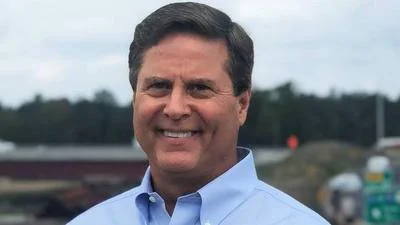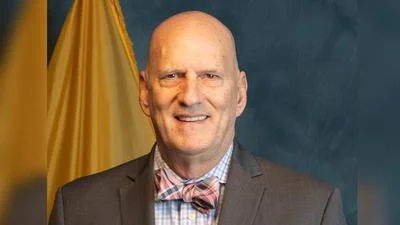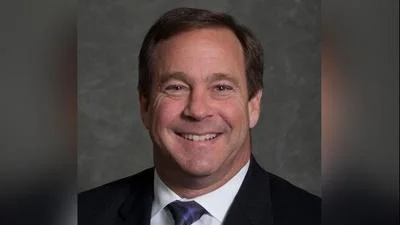The Congressional Record is a unique source of public documentation. It started in 1873, documenting nearly all the major and minor policies being discussed and debated.
“Surface Transportation Plan (Executive Calendar)” mentioning Cory A. Booker was published in the Senate section on pages S2215-S2217 on April 27.
Of the 100 senators in 117th Congress, 24 percent were women, and 76 percent were men, according to the Biographical Directory of the United States Congress.
Senators' salaries are historically higher than the median US income.
The publication is reproduced in full below:
Surface Transportation Plan
Mr. President, we also need to reauthorize the new surface transportation plan before October 1. I know that it can be done because I did it twice with Senator Boxer. We did the MAP-21 program; that was in 2012. We did the FAST Act in 2015. We were successful because we focused on actual infrastructure--roads, highways, bridges, waterways, and the like.
Senator Capito rolled out a meaningful infrastructure package this last week. It is bold and focused on what our country actually needs.
While President Biden and the Biden administration recognize the Republican plan as a starting point, sadly, Senate Democrats dismiss it outright, without even waiting to read it. And why? Because the extreme left wants to hijack the popularity of infrastructure to pass their Green New Deal agenda
You know, I had the honor of being with the President and the Vice President in the White House their first week in office. At that time, they were talking about the infrastructure package of the administration. I told the President at that time that one of the problems I have with what I feel is going to be in his infrastructure package is going to be using the popularity of infrastructure repair. That is popular. People want roads. They want highways. They want infrastructure. But they want to use that popularity to get their agenda passed.
Now, in the infrastructure package that the President came out with, only about 7 percent of that actually addresses roads, highways, and bridges. So that is not what we want. We do have a bill coming out of the committee.
The proof is in the numbers. The Biden plan would spend more on electric vehicle charging ports and subsidies for electric cars than it does on roads, bridges, and airports combined. You know, I didn't believe that when I first saw it. How can he come out with something that would actually spend more just on electrical vehicles than it does on roads, highways, and bridges? But that is exactly right because it would be $157 billion for roads, highways, and bridges but $174 billion for electrical vehicle support.
If this sounds familiar to you, that is because it is. Remember then-
President Obama's American ``Recovery'' Plan that was supposed to be a massive investment in infrastructure with ``shovel ready jobs''? Well, less than 5 percent of that bill went into infrastructure. The rest of the $800 billion went to finance the Obama climate agenda. I guess history really does repeat itself because that same thing is happening today. Worse, it trades responsible pay-for methods with a tax-and-
spend approach.
A lot of people here may be too young to remember this, but I remember when the biggest problem we had in the highway trust fund was that we had too much money, that we had too much surplus.
I ask the Presiding Officer, can you believe that, because you haven't been here that long? But that actually was the problem. The highway trust fund was actually more than it needed to be.
I can remember back during the Clinton administration, I was pretty upset when he took several billion dollars out of that program. The surplus was there--I grant you that--but nonetheless we knew that leaner times were coming and that we would end up with a highway program that we would not be able to pay for out of the highway trust fund if we let people take money out of that trust fund.
But, anyway, a lot of people here may be too young to remember that, but that actually did happen.
One of the unique things about our highway system is the ``user pays; user benefits'' model. At a recent EPW hearing that we had--that was just 2 weeks ago--every single witness was in agreement that users who benefit should pay into the system. They all agreed that electric vehicles should be paying their fair share to maintain and improve our infrastructure. But, instead, the Biden plan takes the tax-and-spend approach, increasing the deficit and raising our corporate tax rate, undoing the historic tax cuts that we achieved under the previous administration, the Trump administration.
People hear that, and they don't fully appreciate just what it means. They think that corporate tax rates won't affect them. But the people hurt the most by the higher corporate tax rate tend to be in the most vulnerable categories. That is because higher taxes on job creators not only hurts American competitiveness around the world, but it means lower wages, lower GDP growth, and fewer jobs to go around.
In fact, the nonpartisan CBO found that 70 percent of the savings businesses got when they lowered the corporate tax rate in the Trump tax cuts went straight to worker wages, and the Biden plan would undo that very successful program. A study done by Rice University found that raising the corporate tax rate back to 28 percent, like the Biden plans do, will actually kill 1 million jobs in just 2 years.
Before the pandemic, the economy was growing fast, thanks in large part to the historic tax cuts and the regulatory reforms that drove the record job growth.
In fact, we had the best economy in my lifetime, prior to the pandemic problem that came along. And now, 12 months into the pandemic, as many States are just now allowing businesses to reopen, the administration is looking to raise taxes on job creators who can get our economy back on track.
The White House said it was serious about infrastructure investment, and I am committed to working with the President and my colleagues in the Senate to do this. It can be done this year, just as it has been many times in the past, but it needs to be real infrastructure and not just a big-spending liberal climate bill.
With that, I yield the floor.
The PRESIDING OFFICER. The Senator from West Virginia
Mrs. CAPITO. Mr. President, I rise today to urge my colleagues to vote for this motion to proceed to the bipartisan Drinking Water and Wastewater Infrastructure Act of 2021, otherwise known as DWWIA.
As the ranking member of the Environment and Public Works Committee, I have been working closely with Chairman Carper and Senators Duckworth, Lummis, Cardin, and Cramer to craft meaningful legislation that addresses our country's aging drinking water and wastewater systems. Every city and town can tell you all about it.
This bill authorizes more than $35 billion for water resource development projects across the country, with a focus on upgrading aging infrastructure, addressing the emerging threats of extreme weather events, including those resulting from climate change, and cyber security vulnerabilities. This bill also includes measures to invest in innovative technologies, and it provides assistance to marginalized communities. All of these things will help our communities keep their water safe and clean.
Something I am particularly proud of is how this bill provides flexibility to both rural and urban areas and lets them decide how they can best address their needs.
The most significant investments in this bill are in the drinking water and clean water State revolving funds. We know them as SRFs. The SRFs maximize authority for the States to determine how best to address drinking and wastewater challenges, utilizing a revolving loan fund to facilitate additional future investments.
For rural States like West Virginia, we offer several solutions to unique water challenges. I will add here that we have a lot of great water in West Virginia. First, the bill invests $50 billion for those currently being served by intractable water systems. Those are the systems that service fewer than 1,000 people and that have typically been abandoned by the operator. We have quite a few of those. Towns in the southern coalfields of West Virginia, like those in McDowell County, have historically struggled with this.
Since many of these households cannot connect to municipal water systems in an economic or technologically feasible way, the funding will go to a grant program to help them install environmentally sound, decentralized wastewater systems. This language is something that I worked on previously with my colleague from New Jersey Cory Booker when he was on the committee in the last Congress.
The most pressing water issue, from a human health and environmental perspective in Appalachia, is undoubtedly straight piping. This practice is common in other exceptionally rural and remote areas around the country. So with new septic tanks installed, the grant program is working to improve quality of life and addresses public health and environmental concerns about straight piping waste into rivers and streams.
Infrastructure resiliency and sustainability is also a priority in this bill. In rural areas especially, some of the pipes are nearly 100 years old. I have actually heard about wooden pipes. Small towns often don't have the revenues to spend on expensive drinking water and wastewater infrastructure upgrades. That is why this legislation creates grants for small public water systems to replace components, to identify and prevent leaks, and to install meters.
This is based off of language I introduced last Congress in the Assuring Quality Water Infrastructure Act. I was joined there by my colleague Ben Cardin of Maryland to address the needs of small water systems that are facing operational challenges in maintaining drinking water services. Every State has them.
In West Virginia, that is often the result of old infrastructure or the lack of adequate mapping of where these assets actually exist. It is hard to fix leaks when you can't find them.
Reports have shown--this stunned me when I saw this--that only one-
quarter of the water that West Virginia water systems pay to have treated and pumped even reaches a faucet--one quarter. That is how much water leaks out. I think about other States that have water shortages, and here we are wasting so much water in a State like ours, which has an abundance of water.
Water is a precious resource, and wasting that much of it because of leaky pipes and faulty infrastructure is absolutely unacceptable. The
$250 million grant program will help provide the technical assistance and infrastructure investments that these small systems, serving 10,000 people or fewer, need to address to get those challenges off their backs and to get on sure fiscal footing as they better serve their customers.
Of course, we don't want to forget about our midsize and large drinking water systems. Another program that I worked on last Congress, again, with Senator Cardin, addresses the resiliency of drinking water and wastewater systems.
Adapted from the Clean Water Infrastructure Resilience and Sustainability Act, these programs, totaling $370 million over 5 years, will help to protect public water systems from a host of threats, both natural and manmade.
In West Virginia and in many other parts of the country, the greatest threats to drinking and wastewater infrastructure come from flooding. These investments will harden infrastructure against these threats and protect taxpayers from paying for the same infrastructure again and again.
I just discussed physical resilience, but we must also ensure the resilience of our water utility workforce, those workers who ensure the continued operation and maintenance of drinking water and wastewater systems every day.
Section 211 of DWWIA focuses on the resilience of America's water utility workforce by addressing recruitment, training, and retention challenges. This is a topic very important to me, and I worked, again, with my colleague from New Jersey Senator Booker, on this issue
I cannot help but think that we regularly take for granted the public health services provided by this Nation's water utility workforce. We just don't really think about who is actually working there and providing the service that we sometimes take for granted.
Unfortunately, a large portion of the men and women who are in our water treatment facilities are getting older and they are retiring, and that is why we need to make sure that we have the next generation of water workers ready.
This bill increases funding authorized to $25 million over 5 years for the program that helps water systems grow their workforce through apprenticeships, through training programs, and it also helps with their retention efforts. This program has been extremely popular with water systems around the country, and Congress has recognized this by funding it beyond the authorization level.
It is critical that we provide the tools and investments necessary to help our drinking water and wastewater systems face these challenges head-on. After all, this is the workforce that will ensure the operation and maintenance of all the other infrastructure investments this package creates.
Additional technical assistance can also help systems with operations--it is much more complicated than what it used to be--and prevent outages and costly compliance issues. Section 206 establishes and authorizes a circuit rider program designed to help owners and operators of small- and medium-sized publicly owned treatment works.
We have heard from the water community that other circuit rider programs have been a tremendous asset in providing technical assistance. It only makes sense for the EPA to similarly provide technical assistance since they implement the relevant regulations. This can be tremendously helpful where a system may be struggling with an insufficient workforce and also must be a part of the resilience discussion.
Another concern for us was the alarming trend in cyber security threats in water systems. In February, you all might remember, hackers accessed a Florida water treatment facility computer system and were able to remotely raise the level of sodium hydroxide in the water. That is not just scary; it is alarming.
This has huge national security implications on top of the obvious public health concerns. Thankfully, that hack was detected and the system was returned to normal before the public was ever at risk. But in this day and age, water infrastructure resiliency also has to include addressing these cyber security issues. So we made sure that these vulnerabilities could be addressed under resiliency grants.
While water infrastructure investments are critical to ensuring we are not wasting water and our water is clean, it is also critical from an economic development perspective. Berkeley County--close here to Washington, DC--in West Virginia made huge investments into their water infrastructure system to ensure the system could handle the volume of water that the brand-new Procter & Gamble plant needed. And it is massive amounts of water, and it is a massive plant. We are very happy that they are there employing over 1,000 West Virginians.
So with that upgraded water system, P&G was able to operate more efficiently and even to expand--and they are still expanding--and that meant more jobs. That kind of opportunity needs to be available everywhere, not just in my home State but in Connecticut and in other places around the country.
These are just a few of the provisions that address and are informed by the particular challenges that face my State. But based on the feedback of my colleagues in both parties and the groundswell of support from various water advocacy groups, it is clear these provisions have broad applicability to help communities all across this beautiful country.
It is why we have such a diverse and growing coalition of more than 70 supporters--from water systems to local governments, to industry, to labor, to environmental organizations--who are supporting this legislation, not to mention that we had a unanimous vote out of committee.
These organizations recognize the value of this legislation and its commonsense and responsible approach to addressing our water infrastructure issues. We will be discussing more of the valuable provisions of this bill on the Senate floor this week, and I look forward to that debate.
In closing, I just want to urge my colleagues to vote in favor of advancing this bill and, later, for final passage. I mentioned it passed unanimously out of committee. There is a big debate in the broader sense: Can Congress get together on infrastructure? This is what I would define as basic, core infrastructure. This, I think, is a good test case for us, and this, I think, is one in which we all have a great interest. Conservatives, moderates, and liberals all came together on this.
I would like to thank my counterpart and my chairman, Senator Carper, and his staff for their work, as well as our Water Subcommittee counterpart chairman, Senator Duckworth, and Ranking Member Lummis.
This bill is proof that we can work together on infrastructure. This is a bipartisan, responsible, meaningful investment. We are taking care of pipes, we are looking out for our environment, and we are putting special emphasis on helping rural and disadvantaged communities. At the end of the day, this bill is really about helping people. This is a bipartisan bill that we can all be proud of.
Again, I ask my colleagues to vote yes on the motion to proceed and again on the underlying bill.
I yield the floor.
The PRESIDING OFFICER (Mr. Markey). The Senator from Alaska.
Mr. SULLIVAN. Mr. President, I ask unanimous consent to be able to complete my remarks, given the time constraints.
The PRESIDING OFFICER. Without objection, it is so ordered





 Alerts Sign-up
Alerts Sign-up